

Acuponcture urbaine. Un article de Wikipédia, l'encyclopédie libre.
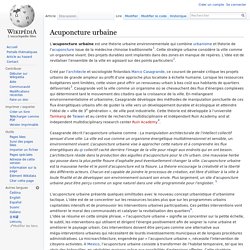
L’acuponcture urbaine est une théorie urbaine environnementale qui combine urbanisme et théorie de l’acuponcture issue de la médecine chinoise traditionnelle[1]. The Arsenal of Exclusion & Inclusion. Some exclusion & inclusion-related stories around the news . . .
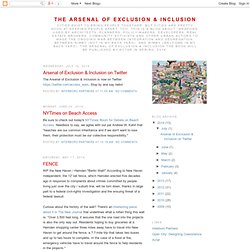
In our rush to promote higher-density urbanism, are we inadvertently creating child-free zones that are inhospitable to families with kids? That's a great question, and it is taken up in this piece in Atlantic Cities. The answer? Pretty much. Here's a thoughtful piece in Architectural Record by Michael Sorkin, who we know and admire.
2012 Maps of the U.S. - Alternative Maps of America. Though we've lived in a post-Fair Housing Act America more than four decades, that doesn't mean there aren't still ways for communities to be discriminatory.
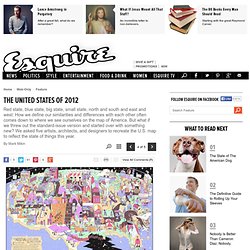
The way Brooklyn-based architecture firm Interboro Partners sees it, a housing discrimination exists still, through what they call the "Arsenal of Exclusion and Inclusion," legal policies that may keep some people in, and keep others out. The policies can be subtle, like in the case of "Ave Maria," a Catholic community in Florida created by Tom Monaghan (the founder of Domino's Pizza), which employs what's called an exclusionary mend: Members of the community are required to pay dues to a Catholic church that's built on the property.
The policies can be outrageous, as in the case of an ordinance in St. Bernard Parish, Louisiana, which mandates that only blood relatives can be rented to by owners of single-family homes, if they had become rentals after the disaster. Animal Zoning Ordinance. Play the City - Play the City. MARCHE OU CRÈVE. Kowloon2.
Jan Gehl. Jan Gehl (born 17 September 1936) is a Danish architect and urban design consultant based in Copenhagen and whose career has focused on improving the quality of urban life by re-orienting city design towards the pedestrian and cyclist.
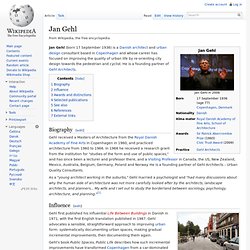
He is a founding partner of Gehl Architects. Biography[edit] Ebenezer Howard - Wikipédia - Waterfox. Georges Eugène Haussmann. Un article de Wikipédia, l'encyclopédie libre. Pour les articles homonymes, voir Hausmann. Georges Eugène Haussmann Photographie d'Haussmann en 1860. Compléments À ce titre, il a dirigé les transformations de Paris sous le Second Empire en élaborant un vaste plan de rénovation, qui a donné lieu aux spéculations haussmanniennes à l'origine du krach de 1873.
Enfance et carrière jusqu'au Second Empire[modifier | modifier le code] Né à Paris le au 55 rue du Faubourg-du-Roule, dans le quartier Beaujon, dans une maison qu'il n'hésita pas à faire démolir, il est le fils de Nicolas-Valentin Haussmann (1787-1876), protestant, commissaire des guerres et intendant militaire de Napoléon Ier et d'Ève-Marie-Henriette-Caroline Dentzel, fille du général et député de la Convention Georges Frédéric Dentzel, baron d'Empire, et le petit-fils de Nicolas Haussmann (1759-1847), député de l'Assemblée Législative et de la Convention, administrateur du département de la Seine-et-Oise, commissaire aux armées.
Robert Moses. Moses's projects were considered by many to be necessary for the region's development after being hit hard by the Great Depression.
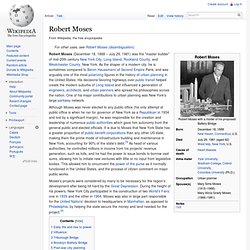
Home - GEHL Architects. Paola Viganò. Un article de Wikipédia, l'encyclopédie libre.
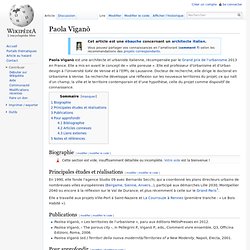
Paola Viganò est une architecte et urbaniste italienne, récompensée par le Grand prix de l'urbanisme 2013 en France. Elle a mis en avant le concept de « ville poreuse ». Villes poreuses. L’invention du balnéaire « cinquante » à Royan. 1 Ce texte synthétise une recherche engagée depuis 1997 et publiée en collaboration avec Thierry Jean (...)

Figure 1 Royan en ruines après les bombardements alliés de 1945 Fonds Ferret, Ecole d’architecture et du paysage, Bordeaux. Extrait : L'invention d'une ville. Royan Cinquante. 2 Claude Ferret (1907-1993) conduit essentiellement une activité d’enseignement jusqu’en 1977, ses pr (...) 1Dans la nuit du 5 janvier 1945, un violent bombardement allié détruit la station balnéaire de Royan à plus de 85 % (fig. n° 1). Figure 2 Portrait de Claude Ferret par Pierre-Albert Begaud, n.d. Phot. 3 Ferret, Claude. « La Nouvelle République », 27 mars 1957. 4 Lucan, Jacques. 2Du milieu des années cinquante jusqu’à son décès en 1993, Ferret a toujours affirmé qu’une seule condition avait guidé son projet : « faire du moderne »3 (fig. n° 2).
Figure 3 Claude Ferret (gauche) et Louis Simon (droite) devant le front de mer, vers 1954 Fonds Simon AN/IFA. Figure 4 Première esquisse du projet urbain, 1945. Royan 1950. Gentrification. Gentrification is a shift in an urban community toward wealthier residents and/or businesses and increasing property values.[1] Gentrification is typically the result of investment in a community by local government, community activists, or business groups, and can often spur economic development, attract business, and lower crime rates.

In addition to these potential benefits, gentrification can lead to population migration, which involves poorer residents being displaced by wealthier newcomers. In a community undergoing gentrification, the average income increases and average family size decreases. Poorer pre-gentrification residents who are unable to pay increased rents or property taxes[dubious ] may be driven out. Often old industrial buildings are converted to residences and shops. Origin and etymology[edit] Gentrification is a multi-faceted phenomenon that can be defined in different ways.[5] Causes[edit]
Commuter town. A commuter town, also known as an exurb, bedroom community (Canada usage, bedroom town or bedroom suburb U.S. usage), a dormitory town or dormitory suburb (UK Commonwealth and Ireland usage), or less commonly a dormitory village (UK Commonwealth and Ireland), suggests that residents sleep in these neighborhoods, but normally work elsewhere; they also suggest that these communities have little commercial or industrial activity beyond a small amount of retail, oriented toward serving the residents.
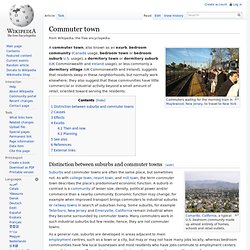
Distinction between suburbs and commuter towns[edit] Camarillo, California, a typical U.S. bedroom community made up almost entirely of homes, schools and retail outlets. Learning from the slums (1/2):literature and urban renewal. “Slumdog Millionaire” is the movie of the year.

Its story of a young guy from Mumbai’s slum of Dharavi, who manages to change its destiny through the “Who wants to be a Millionaire” game has charmed many people, including the Oscars’ jury, who awarded the movie with 8 prizes. At the same time, the movie has created a debate around slums and how the movie portrays them. “Slumdog Millionaire” follows the mainstream vision of slums, described in the XIX century by writers like Daniel Defoe or Charles Dickens: dark, dirty places, with people packed in small rooms with no water facilities. In slums, riots are frequents, and police can hardly enter: the perfect place for criminals to hide and plan their threats to the society, and the perfect incubator for all sort of diseases. Dharavi walkway, (image: Flickr) Glasgow slum, 1871(image: Wikipedia) Garden city movement. Ebenezer Howard's 3 magnets diagram which addressed the question 'Where will the people go? ', the choices being 'Town', 'Country' or 'Town-Country' The garden city movement is a method of urban planning that was initiated in 1898 by Sir Ebenezer Howard in the United Kingdom.
Garden cities were intended to be planned, self-contained communities surrounded by "greenbelts", containing proportionate areas of residences, industry and agriculture. Inspired by the Utopian novel Looking Backward and Henry George's work Progress and Poverty, Howard published his book To-morrow: a Peaceful Path to Real Reform in 1898 (which was reissued in 1902 as Garden Cities of To-morrow). His idealised garden city would house 32,000 people on a site of 6,000 acres (2,400 ha), planned on a concentric pattern with open spaces, public parks and six radial boulevards, 120 ft (37 m) wide, extending from the centre.
Lawless Metropolis: Life in Kowloon Walled City, Then & Now. 5,000 Residents Being Evicted from World’s Tallest Vertical Slum. Corridor Cities Transitway. A map of the officially proposed transitway route (orange), with an alternate alignment proposed by the Action Committee for Transit (blue). References[edit] External links[edit] "Corridor Cities Transitway" - Main project site (Maryland Transit Administration)Maryland State Highway Administration - Draft Environmental Impact Statement and Section 4(f) EvaluationAction Committee for Transit - A group supporting transit in Maryland.BeyondDC: Corridor Cities Controversy - A critique of planning for the proposed route. Chicago school (sociology) Types of cities. Edge city. "Edge city" is an American term for a concentration of business, shopping, and entertainment outside a traditional downtown (or central business district) in what had previously been a residential or rural area.
The term was popularized in the 1991 book Edge City: Life on the New Frontier by Joel Garreau, who established its current meaning while working as a reporter for the Washington Post. Garreau argues that the edge city has become the standard form of urban growth worldwide, representing a 20th-century urban form unlike that of the 19th-century central downtown. Other terms for the areas include suburban activity centers, megacenters, and suburban business districts.[1] Definitions[edit] Garreau established five rules for a place to be considered an edge city (quoted from page 7 of book): Compact City. The Compact City or city of short distances is an urban planning and urban design concept, which promotes relatively high residential density with mixed land uses.
It is based on an efficient public transport system and has an urban layout which – according to its advocates – encourages walking and cycling, low energy consumption and reduced pollution. A large resident population provides opportunities for social interaction as well as a feeling of safety in numbers and 'eyes on the street'.[1] It is also arguably a more sustainable urban settlement type than urban sprawl because it is less dependent on the car, requiring less (and cheaper per capita) infrastructure provision (Williams 2000, cited in Dempsey 2010).[2] Achieving a positive compact city does not just mean increasing urban density per se or across all parts of the city.
It means good planning to achieve an overall more compact urban form: Origins[edit] Urban geography. New York City, one of the largest urban areas in the world Urban geography is the study of areas which have a high concentration of buildings and infrastructure. Predominantly towns and cities, these are areas with a high population density and with the majority of economic activities in the secondary sector and tertiary sectors. It is a sub-discipline of human geography. It often overlaps with other fields of study such as anthropology, urban planning and urban sociology. Urban geographers are primarily concerned with the ways in cities and towns are constructed, governed and experienced.
Architecture City Guide: Copenhagen. This week, with the help of our readers, our Architecture City Guide is headed to Copenhagen. This is our first stop in Europe, and admittedly the selection was not completely unbiased. While studying at the Danish Building Research Institute a few years ago I couldn’t help but fall in love with Copenhagen’s architecture. Urban area. Urban areas with at least one million inhabitants in 2006. By the end of the twentieth century, 47% of the world's population lived in cities, a figure which has risen from 3% since 1800. World map showing percent of population living in an urban environment. There are about 7.1 billion people living on the planet.[1] In 2009, the number of people living in urban areas (3.42 billion) surpassed the number living in rural areas (3.41 billion) and since then the world has become more urban than rural.[2] This is the first time that the majority of the world's population lives in a city.[3] Urban areas are created and further developed by the process of urbanization.
City Beautiful movement. Mixed-use development. Permeability (spatial and transport planning)
Brazilia.